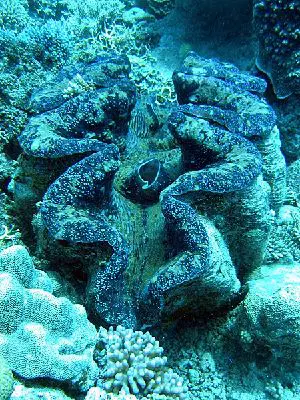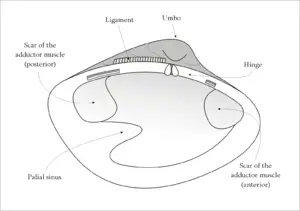Difference between revisions of "Bivalve" - New World Encyclopedia
({{Contracted}}) |
Rick Swarts (talk | contribs) |
||
| Line 35: | Line 35: | ||
}} | }} | ||
| − | '''Bivalves''' are [[mollusk]]s belonging to the class '''Bivalvia'''. They typically have two-part [[animal shell|shell]]s, with both parts being more or less [[symmetry|symmetrical]]. The class has 30,000 [[species]], including [[scallop]]s, [[clam]]s, [[oyster]]s and [[mussel]]s. Other names for the class include '''Bivalva''', '''Pelecypoda''', and '''Lamellibranchia'''. | + | '''Bivalves''' are [[mollusk]]s belonging to the class '''Bivalvia''' ("two valves"), also referred to as class '''Pelecypoda''' ("hatchet-foot"). |
| + | |||
| + | They typically have two-part [[animal shell|shell]]s, with both parts being more or less [[symmetry|symmetrical]]. The class has 30,000 [[species]], including [[scallop]]s, [[clam]]s, [[oyster]]s and [[mussel]]s. Other names for the class include '''Bivalva''', '''Pelecypoda''', and '''Lamellibranchia'''. | ||
Bivalves are exclusively aquatic; they include both marine and freshwater forms. | Bivalves are exclusively aquatic; they include both marine and freshwater forms. | ||
Revision as of 23:06, 16 February 2007
| Bivalve | ||||||
|---|---|---|---|---|---|---|
| "Acephala" from Ernst Haeckel's Kunstformen der Natur, 1904 "Acephala" from Ernst Haeckel's Kunstformen der Natur, 1904
| ||||||
| Scientific classification | ||||||
| ||||||
|
Subclass Anomalosdesmata
Subclass Heterodonta - clams, zebra mussels
Subclass Paleoheterodonta
Subclass Protobranchia
Subclass Pteriomorphia - oysters, mussels
|
Bivalves are mollusks belonging to the class Bivalvia ("two valves"), also referred to as class Pelecypoda ("hatchet-foot").
They typically have two-part shells, with both parts being more or less symmetrical. The class has 30,000 species, including scallops, clams, oysters and mussels. Other names for the class include Bivalva, Pelecypoda, and Lamellibranchia.
Bivalves are exclusively aquatic; they include both marine and freshwater forms.
Bivalves lack a radula and feed by siphoning and filtering large particles from water. Some bivalves are epifaunal: that is, they attach themselves to surfaces in the water, by means of a byssus or organic cementation. Others are infaunal: they bury themselves in sand or other sediments. These forms typically have a strong digging foot. Some bivalves can swim.
Anatomy
Bivalves are filter-feeders that use their gills to extract organic matter from the water in which they live. They have an open circulatory system that bathes the organs in hemolymph. Nephridia remove the waste material. Bivalves are laterally compressed and have a shell composed of two valves. The valved shell makes them superficially similar to brachiopods, but the construction of the shell is completely different in the two groups: in brachiopods, the two valves are on the upper and lower surfaces of the body, while in bivalves, they are on the left and right sides.
History
Bivalves appeared late in the Cambrian explosion and came to dominate over brachiopods during the Palaeozoic; indeed, by the end-Permian extinction, bivalves were undergoing a huge radiation in numbers while brachiopods (along with ~95% of all species) were devastated.
This raises two questions: how did the bivalves come to challenge the brachiopoda niche before the extinction event, and how did the bivalves escape the fate of extinction? Although inevitable biases exist in the fossil record and our documentation thereof, bivalves essentially appear to be better adapted to aquatic life. Far more sophisticated than the brachiopods, bivalves use an energetically-efficient ligament-muscle system for opening valves, and thus require less food to subsist. Furthermore, their ability to burrow allows for evasion of predators: buried bivalves feed by extending a siphon to the surface (indicated by the presence of a palial sinus, the size of which is proportional to the burrowing depth, and represented by their dentition). Additionally, bivalves became mobile: some developed spines for buoyancy, while others suck in and eject water to enable propulsion. This allowed bivalves to themselves become predators.
With such a wide range of adaptations it is unsurprising that the shapes of bivalve shells vary greatly - some are rounded and globular, others are flattened and plate-like, while still others, such as the razor shell Ensis, have become greatly elongated in order to aid burrowing byssonychia. The shipworms of the family Teredinidae have elongated bodies, but the shell valves are much reduced and restricted to the anterior end of the body. They function as burrowing organs, allowing the animal to dig tunnels through wood.
Some pelecypods are alive today in the Great Sea and the Black Sea. Various Eurasian countries rely on them for food.
External links
- Museum of Paleontology - Palaeontology from the University of California, Berkeley
Credits
New World Encyclopedia writers and editors rewrote and completed the Wikipedia article in accordance with New World Encyclopedia standards. This article abides by terms of the Creative Commons CC-by-sa 3.0 License (CC-by-sa), which may be used and disseminated with proper attribution. Credit is due under the terms of this license that can reference both the New World Encyclopedia contributors and the selfless volunteer contributors of the Wikimedia Foundation. To cite this article click here for a list of acceptable citing formats.The history of earlier contributions by wikipedians is accessible to researchers here:
The history of this article since it was imported to New World Encyclopedia:
Note: Some restrictions may apply to use of individual images which are separately licensed.

